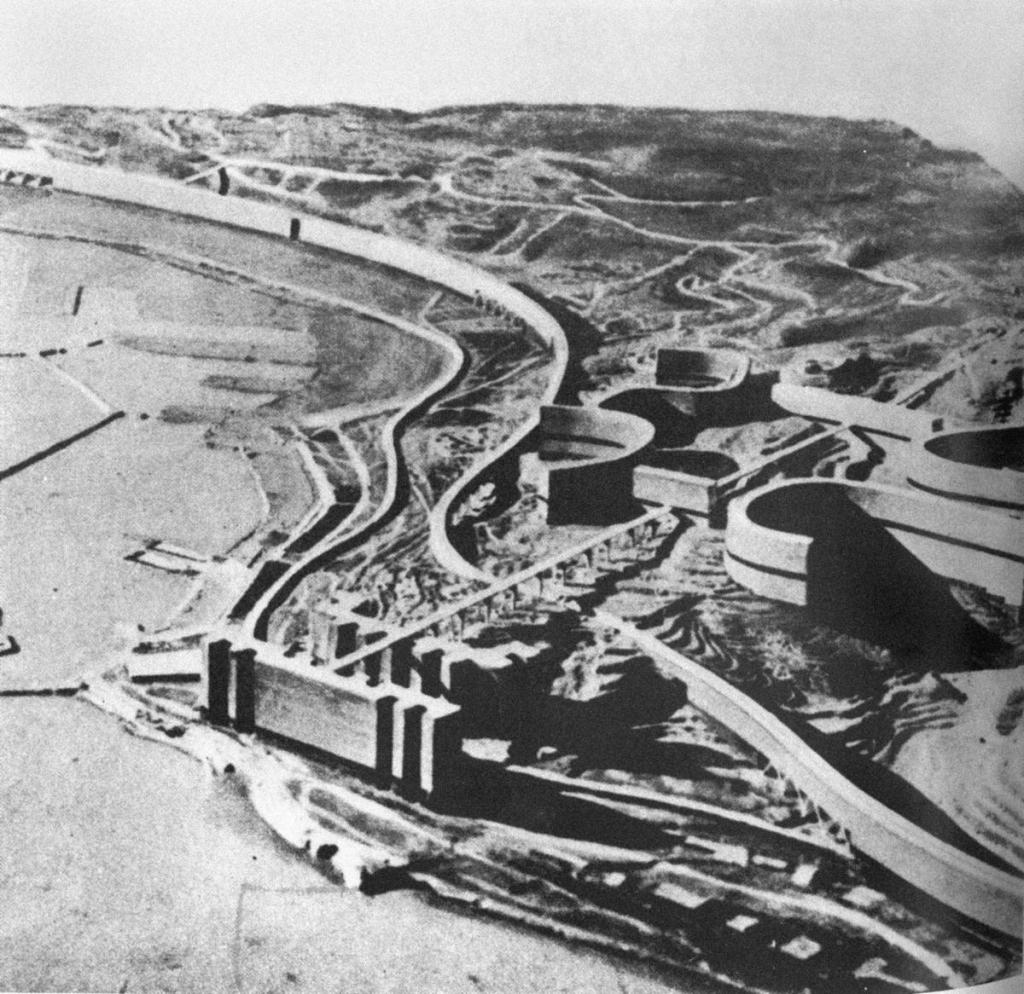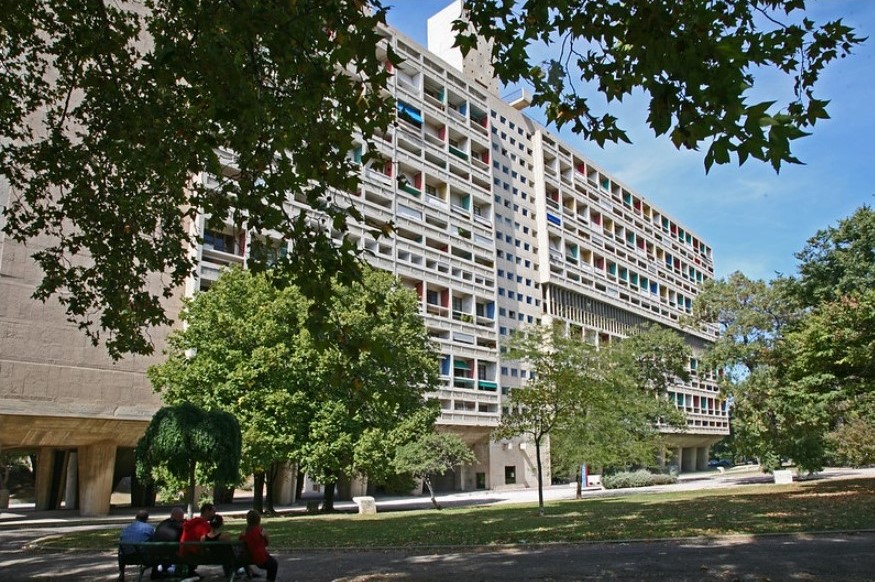In my previous posts – links HERE, HERE, HERE, HERE, HERE, HERE, HERE, and HERE – I was telling a story. It is a story about stories, in that it was prompted by three French journalists telling us a story – namely, that the famous 20th century architect Le Corbusier was a Fascist. It is a personal story, in that I am repulsed by fascism but love Le Corbusier. It is a geo-political story, in that Corbusier was born and raised, quite actually, right in the middle space between French cosmopolitanism and German Nationalism. It is also, of course, a story, about Le Corbusier and his work. And, it is a story with multiple other stories folded up inside a story. I have finished telling those “stories inside a story” of his work, which hopefully began to give a sense of why this blog series carries its title.
So, now I want to address the question more directly. Was Le Corbusier a Fascist, as the “secular liberal” French journalists in question claim? Obviously, I can’t fully address that question here. Other than the books noted in the first post of this series, if interested, the reader can see below for further references [#1 through #5]. I will be linking to some of them where appropriate throughout this blog post.
THERE’S SOMETHING TO IT
Despite the questions, there is indeed good evidence that Le Corbusier was a Fascist. He was privately a member of a militantly right-wing fascist group in the 1920’s [#1, #3Corbusier also worked directly with Fascist leaders of the puppet Vichy regime in France, during WWII, creating urban planning journals, along with urban plans themselves. Their goal, tellingly colonialist, was “national renewal” [#1, #3]. The Marais quarter of Paris, which, as noted in a previous post, Corbusier wanted to raise to make room for his “Radiant City,” contains a thriving Jewish community. Of course, then, while many other artists fled France at the time, he did not [#1].]. Also privately, he supported the Italian and German Fascist movements [#1] of the time. He is reported to have had sympathies more generally with authoritative leaders and was “no democrat” [#3]. The emphasis in the following excerpt from his own writing is original, and reveals, at the least, potentially fascist sympathies:
“[T]he man of initiative, of action, of thought, the LEADER, demands a shelter for his meditations in a quiet and sure spot; a problem which is indispensable to the health of a specialized people.”
Le Corbusier, Towards A New Architecture, p. 20
If we wanted to make the case that he was a Fascist, we could shift the emphasis on his presentation of the house as “a machine for living” – see previous post of this series, HERE – away from that of a question:
“For Le Corbusier, any industrial society must be centrally controlled, hierarchically organized, administered from above, with the most qualified people in the most responsible position. He believed that the industrial era would be an age of triumphant rationality, and, as Max Weber had already observed, the rule of reason in Western society means the dominance of bureaucracy. Le Corbusier did not shrink from this conclusion: he embraced it. His ideal city is above all a City of Administration.”
From the Radiant City to Vichy: Le Corbusier’s Plans and Politics, 1928-1942, by Robert Fishman, Apr 23, 2021, link HERE
Corbusier also worked directly with Fascist leaders of the puppet Vichy regime in France, during WWII, creating urban planning journals, along with urban plans themselves. Their goal, tellingly colonialist, was “national renewal” [#1, #3]. The Marais quarter of Paris, which, as noted in a previous post, Corbusier wanted to raise to make room for his “Radiant City,” contains a thriving Jewish community. Of course, then, while many other artists fled France at the time, he did not [#1].

Corbusier also declared himself in favor of a corporatist state and, related, constantly wrote about the need for increased order and efficiency in society [#1].
“It is evident that such buildings would necessarily be devoted exclusively to business offices and that their proper place would therefore be in the centre of great cities, with a view to eliminating the appalling congestion of the main arteries. Family life would hardly be at home in them, with their prodigious mechanisms of lifts. The figures are terrifying, pitiless and magnificent; giving each employee a superficial area of 10 sq. yds., a skyscraper 650 feet in breadth would house 40,000 people. This section shows how dust, smells, and noise stifles our towns of to-day. Towers, on the other hand, are far removed from all this and set in clean air amidst trees and grass. Indeed the whole town is ‘verdure clad.’ The towers are placed amidst gardens and playing-fields. The main arteries, with their motor-tracks, built over them, allow for easy, or rapid, or very rapid circulation of traffic.”
– Towards A New Architecture, by Le Corbusier, p. 56-7, on his 1920 City of Towers project for Paris
This tells us that Corbusier was the very opposite of a Socialist, and that even his work celebrated authoritarian images of “terrifying, pitiless” monumentality.
The most condemning evidence of his potential fascism was not mentioned in any of the pieces I read on the topic but was discussed previously in “The Governance of the Question” (link HERE). The model for his Modulor Man, which, relevant to the point at hand, was his representation of the ideal man, was a six-foot-tall British policeman. Presumably, he was a white man.
Obviously, Le Corbusier was a fascist.
HOWEVER
Le Corbusier also had sympathy for how Jews were treated [#1] and worked with them [#3]. Nor did he ever, like fascist leaders themselves, make public declarations against Jews [#3, #5].
“In 1940, just days before a Vichy ruling banning Jews from elective office and other professions, Le Corbusier wrote to his mother: ‘The Jews are going through a very bad time. I am sometimes contrite about it. But it does seem as if their blind thirst for money had corrupted the country.’
Le Corbusier’s Architecture and His Politics Are Revisited, by Rachel Donadio, July 12, 2015, link HERE in NYT
But, scholars note, he also built for Jewish families in Switzerland, never publicly denounced Jews and never joined a fascist organization.”[#3]
Corbusier also declared himself a socialist in 1919, and then a conservative in 1920 [#1]. What was that about? Of course, every architect at the time was working with and supporting Fascists – if they wanted work, that is.[#1] He tried but was unable to find favor with the conservative Vichy regime, because he was “too avant garde” [#3]. He also worked with Socialists and designed huge projects in Russia in the ’30s, [#3]. For more information on his work on the Palace of the Soviets, which was never built, you can click HERE. You can see his large and actually-built Tsentrosoiuz building in Russia, HERE.
For such reasons, many people at the time thought Corbusier was a Socialist in exactly the same way that others took him to be a Fascist [#5]. This might also be because, in the late 1920’s, he declared himself a revolutionary syndicalist and, throughout the 1930’s, worked influentially towards trade unions taking control of the means of production and electing their own managerial elite (reference HERE).

I have also seen a number of writers associate Le Corbusier with Communism, because his Unite d’Habitation projects were explicitly and intentionally designed “to house the masses.”
Obviously, Le Corbusier wasn’t a fascist.
Well, that’s confusing. Maybe sometimes things aren’t as clear cut as we would like them to be.
As part of the claim of Corbusier’s fascism, journalists also put forth a number of critiques of his work that, when examined more closely, make little sense. Those arguments come to, very obviously, appear as mere ideological assertions. For example, the ideologues claim that Le Corbusier’s Modulor standardizes and rationalizes the human person [#3]. Did they not read his writings? Did they not pay attention to his actual buildings? As discussed in “The Governance of The Question” (HERE) and “The Mystery of The Question” (HERE), the ancient symbolism of sacred geometry in his work make what appears as a modernist “rationalism” look like something else. And, if Le Corbusier himself repeatedly insists that The Modulor “is not a recipe,” then what is meant by “standardization”? If his idealism was what is meant by “standardization,” then we also have to imagine the ancient Greeks as industrialized mechanists. If, by “standardization,” we mean that he wanted a common means of regulating industrialized mass production, then isn’t one based on harmonious proportions in relation with the human body and nature better than what we’re doing?
Also, remember Corbusier’s use of the axis in his work, as discussed in “The Governance of the Question” (HERE)? For what it’s worth, This is Jewish Architect Daniel Libeskind honoring and borrowing from Corbusier at Libeskind’s Jewish Museum, in Berlin. Those two axes, in the basement of the museum, lead to “The Axis of Exile,” and “The Axis of Holocaust.”
Remember that, when I started telling “stories within a story” of Corbusier’s work, I asked my reader to pay attention to whether and where he was observing and reconciling with the conditions of his environment, as compared to making assertions or proclamations. The reason I want to pay attention to that question is because we tend to assume that political engagement, by definition, if not firstly then exclusively, means being engaged in some kind of political activism, right?
To be a Fascist, one has to be grasping political power for the fascist party, right? Whatever affinities Corbusier apparently did have for fascism, considering his apparent twin affinities for the very opposite of fascism, his work with Communists, the weakness of journalists’ arguments over the complex work of a great architect, and his influence on a similarly famous but more contemporary Jewish architect, I find it difficult to label Corbusier a Fascist. It almost seems like, perhaps, Corbusier’s work itself – like pretty much everything else – serves as a territory over which opposed ideologues compete for power and control in the first place.
REFERENCES:
#1 – https://hyperallergic.com/221158/revisiting-le-corbusier-as-a-fascist/ – Revisiting Le Corbusier as a Fascist, by Joseph Nechvatal, July 10, 2015.
#2 – https://www.smithsonianmag.com/smart-news/controversy-over-le-corbusier-museum-grows-amid-reports-architects-fascist-past-180971949/#:~:text=Le%20Corbusier%20is%20widely%20lauded,with%20strong%20anti%2DSemitic%20views. – The Controversy Over the Planned Le Corbusier Museum, by Meilan Solly, April 15, 2019.
#3 – https://www.nytimes.com/2015/07/13/arts/design/le-corbusiers-architecture-and-his-politics-are-revisited.html – Le Corbusier’s Architecture and His Politics Are Revisited, by Rachel Donadio, July 12, 2015.
#4 – https://news.artnet.com/art-world/new-books-claim-le-corbusier-fascist-289334 – New Books Claim Le Corbusier Was a Fascist, by Cait Munro, April 17, 2015.
#5 – https://www.bbc.com/news/world-europe-32546182 – Do fascist links discredit architect Le Corbusier?, by Lucy Williamson, BBC News, Paris, Published 5 May 2015.

Pingback: WAS LE CORBUSIER A FASCIST? A Question of Assertion or Play? | Knowing God
Pingback: WAS LE CORBUSIER A FASCIST? Our Current Common Conditions | Knowing God
Pingback: WAS LE CORBUSIER A FASCIST? Conclusion and Index | Knowing God